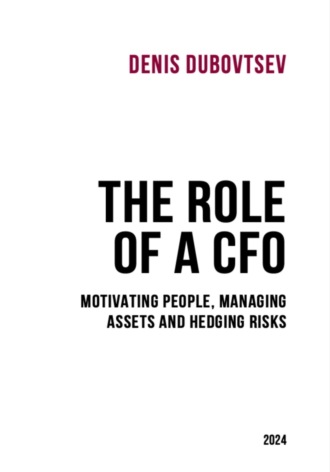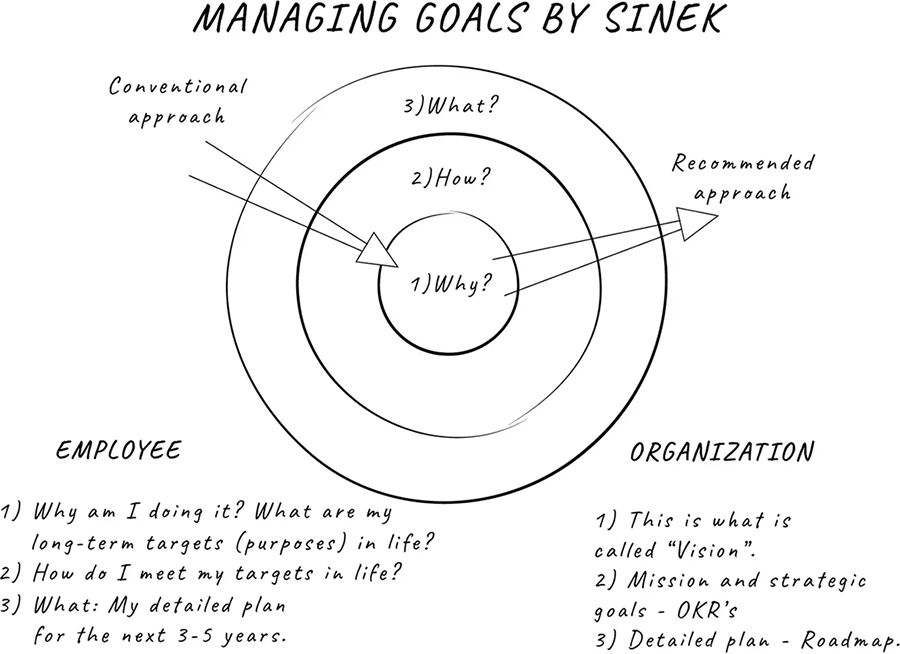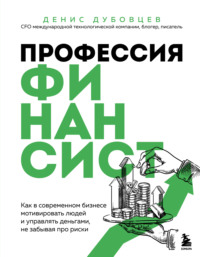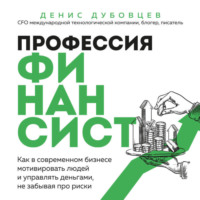
Полная версия
The Role of a CFO: motivating people, managing assets and hedging risks
Company Culture and Decision-Making
When contemplating effective strategies for motivation and goal-setting within a company, it’s crucial to emphasize the role of management culture as pivotal in establishing regular business procedures. This aspect should be addressed early on in the business development phase.
It’s analogous to nurturing a child. If you believe you can neglect someone for ten years and then compensate for it a couple of years later, you’re mistaken. The same principle applies to an organization, its collective, and the processes within.
An organization, a business, is essentially a social construct – a community of individuals with ingrained patterns of behavior, internal cultural norms, rituals, and regulations. Failure to instill the correct culture of working with data, documents, assets, and people in the company from the outset, along with establishing necessary rituals for business development and encouraging (sometimes through negative reinforcement such as reprimands, fines or public dismissals) the right and responsible adult behavior among employees, then your organization, like a child, will grow up as it grows up, and changing its culture and business processes in the future becomes more difficult, sometimes rendering it impossible.
By analogy with raising a child: if decision-making authority isn’t gradually delegated to employees such as middle managers and top executives, then sudden delegation during a crisis due to the owner leaving the business or a shift from an authoritarian or micromanaging CEO will pose a significant challenge for the business and the entire management system. Such systems cannot be built on demand, just as they cannot swiftly transition from a directive, hierarchical management model to a flat, democratic structure with a consultative culture and distributed decision-making centers.
There may be readers who wish to point out inconsistencies between earlier statements (regarding flexible management, setting goals «bottom-up», and most importantly – motivation through positive reinforcement) and the advocacy for nurturing correct behavior occasionally by employing negative reinforcement. There’s no inherent contradiction. I am a staunch advocate of flexible and participatory management approaches. However, they’re effective only when there’s consensus within the team and adherence to certain values, such as intolerance of office politics and intrigue. Sometimes, shaping and instilling the right behavior necessitates firmly addressing an employee’s mistakes and disciplining them for repeating those errors.
To implement a flexible, participatory management system, an appropriate corporate culture, ideally self-organizing and endorsed by leaders within the company, is indispensable. The path to this end is arduous and, as is often the case, attaining the ideal is not always feasible, but one must strive for it to not only keep pace with competitors but to surpass them.
I trust this book will assist business owners and managers in reevaluating their existing management, motivation, and goal-setting processes from a different perspective – viewing them through the lens of constructing an independent and self-developing system. Primary attention should be paid to the attitude toward the formation and improvement of the employee training mechanism. If you look at what’s happening in business from the perspective of parents building a healthy and adaptable system that can autonomously navigate crises, renew itself, identify threats, and address challenges, not just enduring but actively shaping and evolving itself and the surrounding reality for many years and decades, the planning horizon extends significantly into the future, global objectives become clearer, and threats and risks are discerned with greater clarity.
Personal Goals
In the final weeks of the calendar year, I make an effort to bring all my affairs to a logical conclusion or to an intermediate stage, and pause to reflect: assessing what I’ve achieved, where I’ve fallen short, discerning why, and crafting a plan for the next year. This practice is both important and obligatory for me. At the start of the year, in line with the tradition of extended New Year holidays in Russia, I typically embark on a two-week hiatus, traveling to various destinations. During these journeys, I find the time to reflect, and my thoughts naturally gravitate towards scenario modeling and formulating strategic development objectives, both for my family and myself, as well as for departments and the company.
I recommend that CFOs – and not only them – kickstart each year with strategic initiatives. It’s paramount for each individual to contemplate and refine personal goals and life plans. I firmly believe that every person should formulate their own mission and vision for the future, akin to any business or non-profit endeavor, and articulate them clearly and directly. These formulations should not be vague and directed towards everyone and no one simultaneously, but precise and straightforward.
They should stem from personal reflection and analysis, grounded in individual experiences, an understanding of one’s strengths and weaknesses, current personal circumstances, trends, and prospects. You can pursue your goals independently or seek guidance from a mentor, coach, psychologist, or career advisor. Should you opt for external assistance, choose wisely, considering the alignment of values, experiences, current life situations, and aspirations.
A useful tool to employ is Simon Sinek’s well-known approach: the system of questions (visualized as concentric circles) «Why, How, What». The essence of the method echoes the principle I elucidated earlier: in any endeavor, it’s crucial to ascertain why you’re undertaking it (Why). This serves as the cornerstone of the motivation system, ranging from the mundane «Why do you brush your teeth?» to profound inquiries like «Why do I pursue my career?» or «What is my purpose in life?».
At first glance, the answers to these questions may appear self-evident and unworthy of attention. However, this isn’t the case. By sincerely and confidently questioning routine tasks and responding to them honestly and confidently, one can uncover numerous areas for process improvement, leading to an enhanced quality of life and satisfaction with completed tasks. It’s imperative not to overdo it, avoiding becoming fixated on self-improvement or pursuing efficiency blindly.

For example, answering the question «Why do I brush my teeth in the morning?» prompts more thorough oral hygiene practices (brushing correctly for two minutes), reconsideration of tools, and monitoring their condition (utilizing an electric toothbrush and replacing brush heads every three months). Reflecting on the question «Why do I pursue my career?» compels one to contemplate deeper motivations, transcending thoughts of income or ego gratification. This may involve pondering: «Why did I choose this profession, and is it the right fit?» or «What are my values and life aspirations?» or «Does my daily work align with my life objectives?».
After defining core goals for oneself, it’s essential to devise an action plan and proceed with its execution. Describe what needs to be done and how (How), establish deadlines (When), then outline the big picture (What) and prepare a detailed plan (roadmap) for implementation. In many respects, Why corresponds to what is often termed vision in business, How to the mission and strategic goals, and What to the five-year objectives and tasks, further broken down into specific objectives and key results (OKRs). The latter are delineated into clear tasks based on implementation parameters, assessed quantitatively or at the very least dichotomously (yes or no), and assigned deadlines for completion within a month, quarter, or year.
Incidentally, it’s beneficial to conduct a mid-year review of your goals and plans. The world around us and the business environment change rapidly, and so do our attitudes and values. Therefore, come the end of June, it’s imperative to reassess your annual and long-term goals, analyze achievements over the preceding six months, and undertake a plan-versus-actual analysis. You’ll likely identify areas necessitating adjustments, goals warranting refinement, and opportunities for acceleration.
Chapter 3
Objectives and Key Results (OKR)
Key Features of OKR
One significant deviation in utilizing Objectives and Key Results (OKR) from other systems of motivation founded on quantitative goals is that the set objective should not be inherently attainable within the designated timeframe. Achieving it at 75 % is deemed a complete success, while hitting 100 % suggests insufficient ambition for the stated target. In essence, to achieve exceptional results, an individual must step outside their «comfort zone». Simply put, when establishing OKRs, one should acknowledge beforehand that achieving them with current work methods is unattainable. Altering these methods should result in a breakthrough and exponential growth in target metrics.
Конец ознакомительного фрагмента.
Текст предоставлен ООО «Литрес».
Прочитайте эту книгу целиком, купив полную легальную версию на Литрес.
Безопасно оплатить книгу можно банковской картой Visa, MasterCard, Maestro, со счета мобильного телефона, с платежного терминала, в салоне МТС или Связной, через PayPal, WebMoney, Яндекс.Деньги, QIWI Кошелек, бонусными картами или другим удобным Вам способом.
Примечания
1
CFOblog: https://cfoblog.pro/en/
2
Due diligence is a process of forming an independent, objective opinion about the state of a business. This procedure involves analyzing investment risks, verifying key aspects of the business, assessing the accuracy of financial statements, and evaluating the extent to which internal control procedures and processes have been developed.





